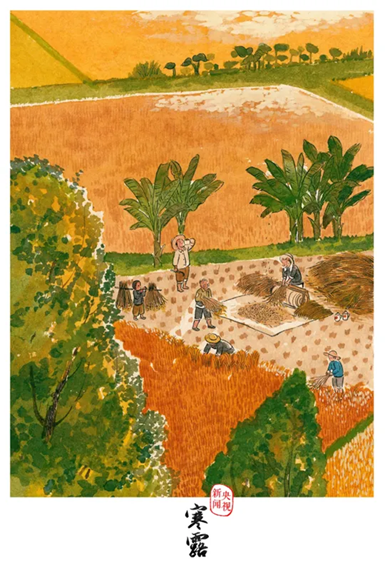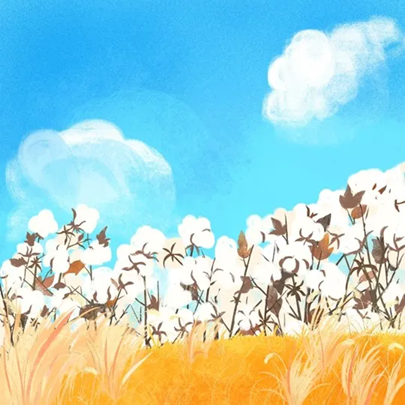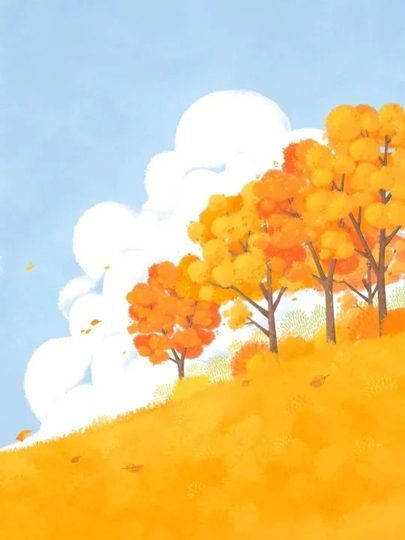
寒露·一隅
Cold dew · a corner
执一笔纯真,画一隅烟火,赠你一方生趣。
Hold a brush of innocence, paint a corner of fireworks, give you a side of life.

寒露三候
Cold dew three days
古人对寒露物候的描述是:一候鸿雁来宾,二候雀入大水为蛤,三候菊有黄华。
The ancients described the phenology of cold dew as follows: the Hongyan guest in the first waiting, the sparrow in the second waiting for the clam, and the chrysanthemum in the third waiting for the yellow flower.
白露物候是“鸿雁来”,寒露物候是“鸿雁来宾”,说的是白露时鸿雁的迁飞工作逐渐启动,寒露时迁飞工作陆续收尾。谚语说:“大雁不过九月九,小燕不过三月三。”是说大雁最迟(农历)九月九,该走的都走了;小燕最迟(农历)三月三,该来的都来了。
White Dew phenology is "Hongyan coming", cold dew phenology is "Hongyan guest", which means that the migration of Hongyan in white dew gradually starts, and the migration of Hongyan in cold dew gradually ends. As the saying goes, "The wild goose is only on September 9, and the small swallow is only on March 3." It is said that geese at the latest (lunar) September 9, should go are gone; Xiaoyan at the latest (lunar calendar) on March 3, the should have come.
所谓“雀入大水为蛤”,是说深秋时节,人们难觅飞雀,但见海边很多蛤蜊,其贝壳的纹和色与雀相似,便以为雀变成了蛤。这是古人质朴的想象。这虽是误解,却是一种浪漫的生命观:在时节的交替和季节的轮回中,生命并未凋谢,只是变换了存在的方式而已。想飞时,有翅,能高飞于天;想藏时,有壳,可深藏于海。
The so-called "birds into the water as clams" means that in late autumn, people can hardly find flying birds, but when they see many clams on the beach, the pattern and color of their shells are similar to those of the birds, they think that the birds have become clams. This is the simple imagination of the ancients. This is a misunderstanding, but it is a romantic view of life: in the alternations of seasons and the cycle of seasons, life does not fade, it just changes the way it exists. When you want to fly, you can fly high in the sky with wings; When you want to hide, there is a shell, but it can be hidden in the sea.
“露凝千片玉,菊散一丛金”,凄凄寒露时节“菊有黄华”。虽然菊花被视为傲寒的标识,农历九月也被称为菊月,但还有一种花,往往被文人们忽视,那便是棉花。“寒露时节尾花收。寒露不收棉,霜降莫怨天。”在农人的眼中,棉花才是秋季的“尾花”。所以农历九月,也是人们的纳棉之月、授衣之月。
"Dew coagulating thousand pieces of jade, chrysanthemum scattered a cluster of gold", "chrysanthemum has yellow Hua" in the cold dew season. Although the chrysanthemum is regarded as a symbol of cold, the ninth month of the lunar calendar is also known as the Chrysanthemum moon, but there is another flower, often overlooked by the literary people, that is cotton. "The tail flowers gather in the cold dew season. If the cold dew does not harvest cotton, do not blame the sky for the frost." In the eyes of farmers, cotton is the autumn "tail flower". Therefore, the ninth lunar month is also the month of people's cotton and clothing.


秋天中的秋天
从前,漫长的岁月,人们跟着节气过日子,无论农桑,还是风物,无论起居,还是行止。
In the past, for a long time, people followed the solar terms to live, whether it was agriculture, or wind, whether it was living, or walking.
有句谚语叫:“九月狗纳日,十月日生翼。”是说到了农历九月,秋阳难得,就连狗都知道抓紧时机晒晒太阳。到了十月,白昼短暂,又难得响晴,太阳就像长了翅膀一样,一不留神就飞了。渐渐地,“负暄”(晒太阳)便成为一种不可多得的免费养生。
There is a saying that goes, "In September a dog gets its day, in October it gets its wings." When it comes to the ninth lunar month, the autumn sun is rare, and even the dog knows to seize the opportunity to bask in the sun. In October, the day is short, and rarely sunny, the sun is like a long wing, a careless fly. Gradually, "negative xuan" (sun) has become a rare free health.
“寒露百花凋,霜降百草枯”,随着气温的下降,“草木荣华滋硕之时”已成往事,所以深秋又被称为“穷秋”。
“Cold dew flowers wither, frost drop paraquat", with the decline in temperature, "the time when the grass and trees are flourishing" has become a thing of the past, so late autumn is also known as "poor autumn".
“寒露洗清秋”,此时节,“云悠而风厉”。标志性的景色便是“碧云天,黄叶地”。寒露时节,有一种明净,叫作望穿秋水。遗憾的是,那样的水少了,那样的天也少了。
“Cold dew wash clear autumn", this time, "clouds and wind severe". The iconic scene is "blue sky, yellow leaves". During the cold dew season, there is a bright and clean, called looking through the autumn water. Unfortunately, there is less water and fewer days.
有人说,寒露,是秋天中的秋天。“虽惭老圃秋容淡,且看黄花晚节香。”好吧,就在这清冽的日子里,观赏秋天绚烂的“晚节”吧。
Some people say that cold dew is autumn in autumn. "Although the old garden is light in autumn, and look at the yellow flowers at night." Well, on this crisp day, enjoy the gorgeous autumn "evening Festival".
